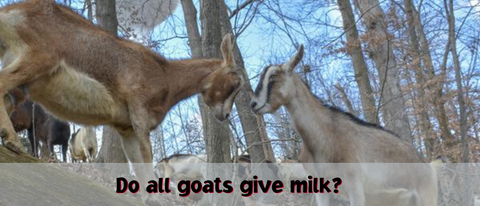
Do All Goats Give Milk?
Share

Although all healthy, female goats are capable of producing milk to feed their babies, not all goats produce enough milk to provide humans with a reasonable share of that milk.
There are three types of goats – dairy goats, meat goats, and fiber goats. As their names indicate, these types of goats have been bred for specific purposes, to give either high quantities of milk, high quantities of meat, or high quality fiber. Some of the popular dairy goats are Alpines and Saanens, while the meat breeds include Boers and Kikos. Angora and Cashmere goats produce mohair and cashmere. There are also mini breeds and dual-purpose breeds such as Nubians that were bred to give a moderate amount of both milk and meat.
In order to give milk, a goat must first get pregnant and have kids of her own. Her body creates the milk to feed the kids. Dairy breeds have been bred to give more milk than their kids would require.
At Goat Milk Stuff, we raise our goats with the goal of having them large enough to freshen (deliver kids) around their first birthday. We milk the goats for ten months and then dry them off two months before they have kids again around their next birthday. This dry period is necessary for them to have enough energy to grow their kids.
Individual goats give different amounts of milk. Over the course of their 10 month lactation, their milk output will follow a general lactation curve. Many different variables can affect this lactation curve - genetics, age, health, nutrition and number of kids can all play a role.
Some goats give so much milk that they are able to “milk through” into a second year. Occasionally a goat will give milk without having kids – this is referred to as a precocious udder. And bizarre as it seems, there have even been bucks that have been known to give milk (yes, all bucks have teats, and no, a milking buck is not normal).

Disclaimer: This information is provided as an example of how we personally raise goats at Goat Milk Stuff. We are not veterinarians and any information on the GMS website should not be taken as veterinary advice. Please seek the advice of a professional vet before making any changes to your herd management or individual treatment of your goat.
4 comments
So is all goats milk so strong/ pungent? Are there breeds of goats that give milder milk?
Hi, i saw that you answered a question on do goats have to be bred to produce milk. I have a mini lamancha that is 4 months old, and she has a full bag that produces milk and she has never been bred. So any ideas as to how a young goat would be able to produce milk? I milk her mother every day and now Lily is producing milk also. I do not own a male goat nor has she ever been exposed to a male goat. Any help would be greatly appreciated.
We have a four year old Alpine doe, never kidded, and she is making milk. Our Grand dam milked for three, then for two and a half years for her second kidding. The mother of the Alpine mentioned, and the first doe of our grand dam milked for just under three years. ( three gallons total per day). Our gran dam is now ten and starting to make udder/milk again, about two years since her last kidding. We also have a Buck whom has been making milk for about two years now, and his Uncle started to form an udder about 4 months ago. We have been unable to continue to relieve the udder pressure by milking him (gave up on trying to capture it due to the rodeo trying to milk a buck-extremely weird.)
Do you know how to dry up this buck?
Thank you for your time and information.
Thank you for making the comment about a goat without kids that can have milk. Called a precocious utter . My two-year-old Nubian crossed goat , all of the sudden she has milk . we do have a Male but he is castrated and another female that is not producing milk. Everything I was reading said the goats had to be bred to have milk. Thank you so much for clearing up why she has milk.